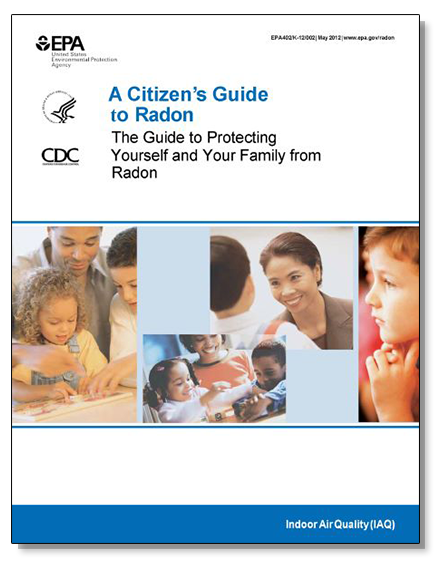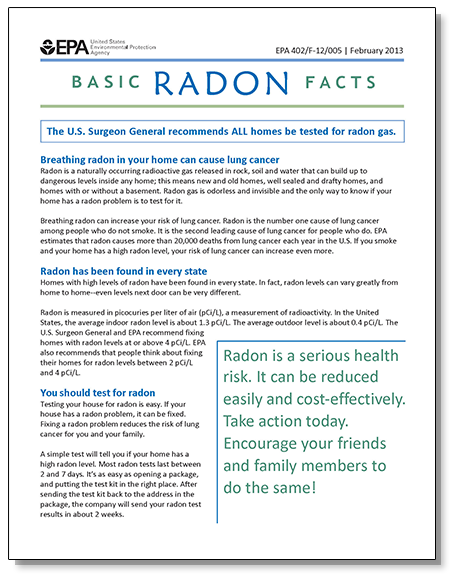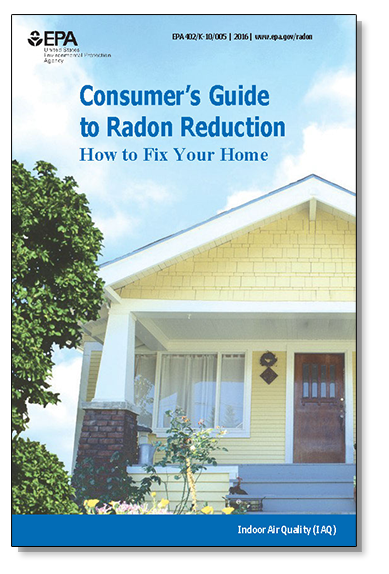Frequently Asked Questions
Should I test my home in Texas for radon?
On average, radon concentrations in Texas are lower than other parts of the United States, but concentrations of radon in Texas residences can still exceed the EPA limit of 4 pCi/L. It is recommended that all homes be tested for radon to ensure a healthy, indoor air environment.
Where can I obtain a radon test kit?
Most indoor radon tests are short-term tests performed using simple activated charcoal canister kits. These kits are available from local hardware stores for approximately $15-$25, or you may request a free radon test kit, depending on where you live.
Long-term tests are generally recommended when results from short-term tests show radon values between 4 and 8 pCi/L. Long-term tests are also available from local hardware stores but are more costly.
How do I test for radon?
Radon testing kits are easy to use, but it’s important that you follow the guidelines that come with the kits, as instructions vary with type.
Short-term home testing kits are typically placed in a home for 2-7 days, depending on type, before they are sealed and mailed to a certified laboratory for analysis. Long-term tests require 90+ days.
"A Citizen’s Guide to Radon" is an EPA publication that describes in detail where to place home radon tests, but a few general guidelines are provided below.
- Always follow the instructions that come with your test kit.
- If you are doing a short-term test, close your windows and outside doors and keep them closed as much as possible during the test.
- If you are doing a short-term test lasting just 2 or 3 days, be sure to close your windows and outside doors at least 12 hours before beginning the test too.
- You should not conduct short-term tests lasting just 2 or 3 days during unusually severe storms or periods of unusually high winds.
- The test kit should be placed in the lowest lived-in level of the home (for example, the basement if it is frequently used, otherwise the first floor).
- Radon test kits should not be placed in kitchens, bathrooms, or on granite countertops.
- Place the kit at least 20 inches above the floor in a location where it won’t be disturbed—away from drafts, high heat, high humidity, and exterior walls.
My home radon results are high. Why might this be, and what do I do?
The EPA considers radon levels to be"high" when they exceed 4 piC/L. There are many reasons for elevated radon concentrations. Common reasons include:
- Winter testing: Radon concentrations are most likely to be elevated during the cold winter months when home heating systems are in high use.
- The radon test kit was placed on a granite countertop. Natural rock formations–such as granite–can emit lowlow levels of radon that are concentrated close to the mineral (countertop) surface. This may make it seem that home radon concentrations are higher than they actually are.
If radon concentrations from a short-term test in your home exceed 4 pCi/L, it’s best to run a second radon measurement test using either a second short-term or a long-term test.
- A long-term test is recommended for radon concentrations between 4 and 8 pCi/L.
- A second short-term test recommended for radon concentrations exceeding 8 pCi/L.
If the average of the two short-term tests and/or results from a long-term test exceed 4 pCi/L, you may need to consider a radon mitigation system. More information on follow-up testing procedures can be found in "A Citizen’s Guide to Radon."
Where can I find a certified radon tester and/or mitigator?
Certification for radon services is a state-mandated process, typically under the auspices of the Department of Health and Human Services. At this time, the State of Texas does not require certification for radon services. However, some radon service providers have opted to become certified.
The National Radon Proficiency Program lists radon testers and mitigators within Texas that have passed a rigorous national certification program. A list of these individuals can be found at National Radon Proficiency Program.
Local home inspectors in your area may also perform radon testing.
What are some beginner-friendly publications?
All Radon Resources
Radon
-
Address
911 Boston Ave | Box 41023 | Lubbock, TX 79409-1023 -
Phone
806.834.0370 -
Email
kayleigh.millerick@ttu.edu



